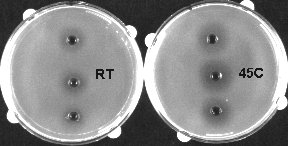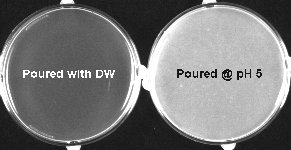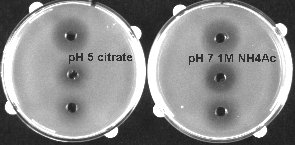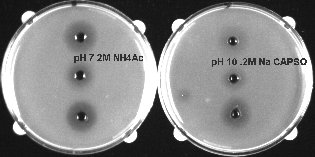Xylanase assay by radial diffusion
Radial diffusion assays are "quick and dirty" methods for detecting and quantitating (roughly) hydrolytic enzymes. They involve incorporating a polymer (xylan in this case) into an agarose gel, cutting a hole in the gel, introducing enzyme into the hole and then detecting the "zone of clearing" produced by polymer hydrolysis. Oat spelt xylan is a good substrate choice because it's semisoluble and detectable by light scattering. Digestion produces a clear zone around enzyme containing wells. Zone diameter is proportional to the amount of enzyme in the well and length of digestion.
For my assays 1% oat spelt xylan was incorporated into 0.5% agarose gels. Mixtures were autoclaved and after partial cooling gels were poured into 50x9mm plastic Petri dishes. After the gel solidified, plates were flooded with buffer for 1 hr, buffer was poured off, wells were cut with a #1 cork borer. A solution of commercial xylanase (Thermomyces lanuginosus) served as a standard. Partially purified preparations from Bacilli isolated from lakes in western Nebraska were also tested. Initial buffers were a: 0.1 M trisodium citrate adjusted to pH 5 with citric acid, b: An equimolar mixture of monobasic and dibasic potassium phosphate (pH 6.8) and c: 0.1M CAPSO, plus .1M sodium CAPSO (pH 9.5).
The following were photographed with a Biorad Chemidoc and epi-illumation
Upper - Thermomyces, Middle - Bacillus PXY 22, Lower - Bacillus PXY 21
Diffusion was for 3 hrs @ 45C
Clearing zones are appreciably larger at 45C than at RT as shown by the pH 9.5 plates (below)
Upper - Thermomyces, Middle - Bacillus PXY 22, Lower - Bacillus PXY 21
Diffusion was for 3 hrs
Oat spelt xylan is less soluble if the gel solution is autoclaved with pH 5 citrate buffer (see below). This suggests that the xylan contains carboxyl groups which inhibit dissolution at low pH
Upper - Thermomyces, Middle - Bacillus PXY 22, Lower - Bacillus PXY 21
Enzymes were tested on a plate equilibrated with 1M ammonium acetate and showed good activity (below)
Upper - Thermomyces, Middle - Bacillus PXY 22, Lower - Bacillus PXY 21
Diffusion was for 3 hrs @ 45C
Upper - Thermomyces, Middle - Bacillus PXY 22, Lower - Bacillus PXY 21
Diffusion was for 5 hrs @ 45C




